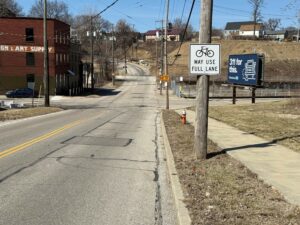
Take it from a bike lawyer, knowledge equals greater safety. Need to know where cyclists can ride their bikes on the road in Ohio? Read on and be better prepared for your next cycling adventure.
Bicycles ARE Vehicles!
Bicycles and electric bicycles (e-bikes, which have electric motors) as defined in Title 45 of the Ohio Revised Code (ORC) are legal road “vehicles” § 4501.01(A)(K) (2019), § 4511.01(A)(G) (2019). Bikes are legal on Ohio roadways, except on divided, controlled access freeways. § 4511.07(A)(8) (2006), § 4511.051(A)(2) (2019), § 4511.01(YY) (2019). Cyclists should follow traffic laws, including riding in the direction of road traffic and obeying traffic control devices, to ensure safe operation.
What if There Are Bicycle Lanes Available?
Bike lanes are currently optional for cyclists. Bikes and e-bikes, as legal road vehicles, can ride on the road (except on divided, controlled access freeways) in the regular lanes for traffic even when there is a bike lane present and even if the road is single lane. Bikes and electric bicycles must ride in the direction of/with the flow of traffic. Wrong way (aka contraflow) riding is not legal except in a two-way bike lane.
Can Cyclists Be Confined to Riding on the Sidewalk?
Cyclists can’t be forced to ride on sidewalks! Ohio Law provides that persons riding bicycles cannot be restricted to riding on a sidewalk § 4511.711(A) (2021). Many local Ordinances have a ban on sidewalk riding, however, making it illegal for a bicycle operator to ride on a sidewalk, especially in a designated business district or a congested area!
It is perfectly legal for cyclists to ride on sidewalks (absent a local ordinance prohibiting it or a temporary restriction which could be indicated by official signage or a law enforcement officer). Research your local traffic regulations! Don’t rely on your general knowledge of the bike lanes of neighboring cities. Local authorities cannot force you to ride on the sidewalk, however § 4511.711(A) (2021).
Please note: Safe operation is the law even when sidewalk riding is allowed. Cyclists must yield to pedestrians, who legally have the right of way (ROW) on sidewalks § 4511.441(A) (2018). Cleveland (and many municipalities) requires an audible signal from a cyclist passing a pedestrian. Cleveland, Ohio, Municipal Code, Part Four-Traffic Code, Title IX-Pedestrians, Bicycles and Motorcycles, Chapter 473-Bicycles, Motorcycles, Mobility Devices, § 473.09(c) (2020).
Cyclists Cannot Be Required to Ride on the All Purpose Trail
Cyclists can’t be confined to riding on the “all purpose” trail in the Metroparks or elsewhere § 4511.07(A)(8) (2006). PLEASE keep in mind when driving a motor vehicle that the avid cyclists you see riding their bikes on the road are doing so legally. The Cleveland Metroparks trail is not exclusively a “bike trail”. It’s an all purpose trail for walkers, hikers, and leashed dogs, generally with no posted speed limit. Users tend to go comparatively slower. (Note: Cuyahoga Valley National Park is 15mph.) Bikes are sometimes also slower vehicles, depending on the riders, and are definitely allowed on the all purpose trail. The exception is Class 3 e-bikes. That said, cyclists often constitute faster traffic than pedestrians due to the higher maximum speeds of bikes.
In the Metroparks bicycle traffic IS traffic. Motorists must maintain both a safe distance from and a safe passing distance around bikes. It’s the law! This includes adequate sight distance when passing cyclists, and NEVER passing on blind curves. Valley Parkway is a road, and bikes are legal on it! It’s a park, not a freeway; motorists don’t own Valley Parkway! Cyclists have a legal right to ride on the road including in the Metroparks, following all traffic rules applicable.
Where Can Cyclists Ride on the Road? Keeping to the Right of a Lane + Taking the Lane
Ohio law provides that cyclists must ride as near to the right side of the roadway as is “practicable” i.e., basically reasonable § 4511.55(A). If it will constitute unsafe operation § 4511.55(C), however, it isn’t required. There are many valid reasons for not staying at the road’s near right side. A cyclist might need additional space to avoid fixed or moving objects and hazardous surfaces. Parked and moving vehicles are two examples.
A cyclist can take the full (whole) lane in a lane too narrow for a motor vehicle to safely pass the cyclist side-by-side. The motorist must wait for an opportunity to safely pass the cyclist (or group of cyclists). What is the best way to know when a lane is too narrow for a car to safely pass a cyclist? When a local authority posts a sign stating that the cyclist may take the full lane.

Knowledge is Power . . . and Safety
As an experienced Cleveland bike crash attorney, I know that nobody likes to think about fatal bicycle crashes. Not bicycle operators, not motor vehicle operators, and definitely not any of their loved ones! Yet the bike accident rate remains far too high. Greater understanding is needed between road users regarding where cyclists can ride their bikes on the road in Ohio. It can help keep driving safer for all, particularly the more vulnerable lives of bicycle riders.
***
Ohio traffic laws mentioned in this article can be viewed online in the Ohio Revised Code, Title 45
